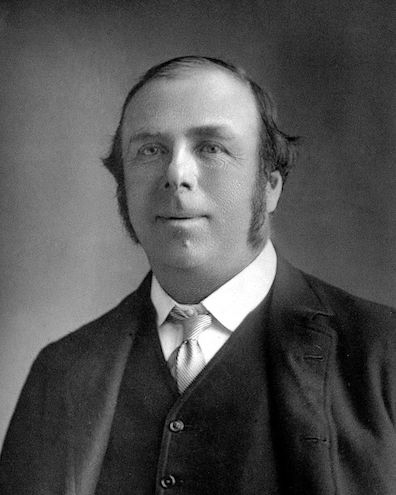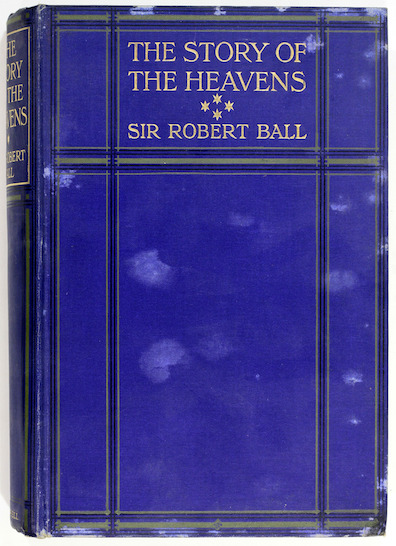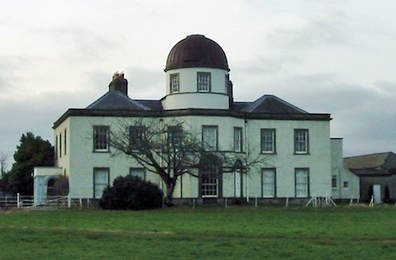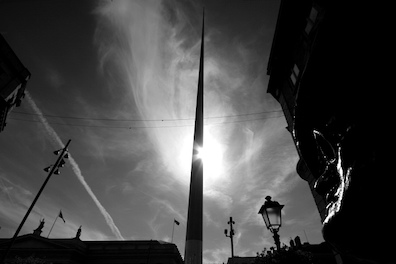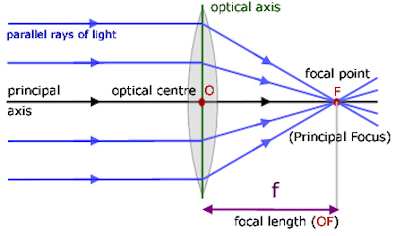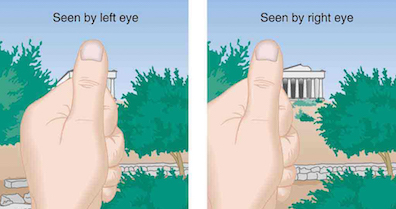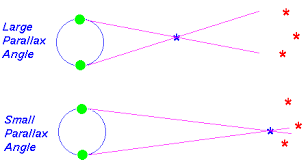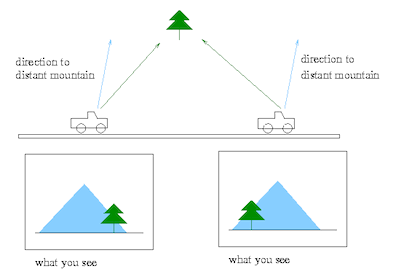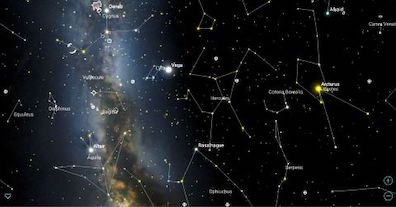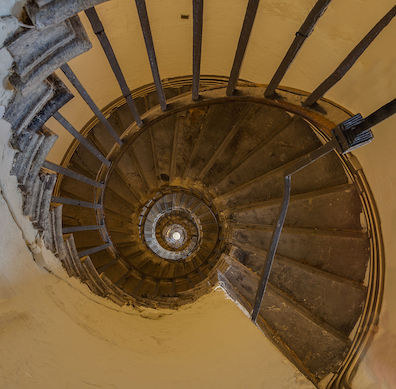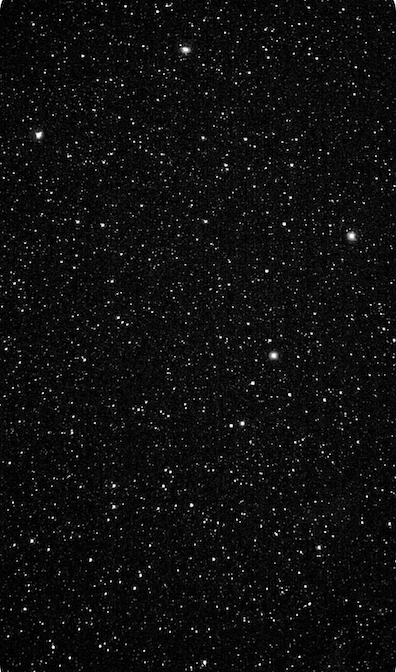Walking past the
Aston Quay "timeball" that
fell each day at 1 PM to let ships on the Liffey reset their
chronometers, Bloom thinks that it runs on time established by
the Dunsink Observatory on the northwest edge of Dublin, which
in turn reminds him of a Dublin-born astronomer who had long
been the director before taking a post at Cambridge in 1892: "
After
one. Timeball on the ballastoffice is down. Dunsink time.
Fascinating little book that is of sir Robert Ball's.
Parallax. I never exactly understood. There's a
priest. Could ask him. Par. It's Greek. Parallel, parallax."
Dictionaries of ancient Greek define
parallax as the
adverbial form of
parallassein = to change. Like
"parallel" it is built from the prefix
para = beside,
near, beyond, apart from, contrary to.
Sir Robert Ball (1840-1913) delivered some 2,500 lectures on
popular science and wrote about astronomy in straightforward
prose.
Ithaca reveals that his "little book,"
The
Story of the Heavens (1886), sits on Bloom's bookshelf in
"blue cloth" covers. The book often employs the concept of
parallax in somewhat challenging ways, but it illustrates the
basic idea with an experiment that any sighted person can
perform:
We must first explain clearly the conception which
is known to astronomers by the name of parallax; for it
is by parallax that the distance of the sun, or, indeed, the
distance of any other celestial body, must be determined. Let
us take a simple illustration. Stand near a window whence you
can look at buildings, or the trees, the clouds, or any
distant objects. Place on the glass a thin strip of paper
vertically in the middle of one of the panes. Close the right
eye, and note with the left eye the position of the strip of
paper relatively to the objects in the background. Then, while
still remaining in the same position, close the left eye and
again observe the position of the strip of paper with the
right eye. You will find that the position of the paper on the
background has changed. (181-82)
A recursive loop later in Lestrygonians indicates
that Bloom may have grasped the idea here: different lines of
sight will afford slightly different contextual views of an
object. Standing in front of Yeates & Son, a shop that
sold precision optics, he recalls that the timeball on the
quayside corner of the Ballast Office was linked not to
Dunsink but to the Greenwich Observatory southeast of London.
Dunsink time was displayed on the clockface on the building's
Westmoreland Street façade: "Now that I come to think of
it, that ball falls at Greenwich time. It's the clock is
worked by an electric wire from Dunsink. Must go out there
some first Saturday of the month. If I could get an
introduction to professor Joly or learn up something about
his family. That would do to: man always feels
complimented. Flattery where least expected. Nobleman proud to
be descended from some king's mistress. His foremother. Lay it
on with a trowel. Cap in hand goes through the land. Not
go in and blurt out what you know you're not to: what's
parallax? Show this gentleman the door. / Ah. / His hand
fell again to his side. / Never know anything about it. Waste
of time." More in a moment on Bloom's raised hand, which
strongly suggests that he once tried Sir Robert's experiment.
In 1904 the Dunsink observatory was indeed open to the public
on the first Saturday of every month, and another eminent
Irish astronomer, Charles Joly, was the director. Bloom
supposes that if he showed up for one of these open houses,
flattery might induce Joly to disclose a mystery that learned
scientists keep hidden from ordinary people. In addition to
the divide between amateurs and professionals, social class
plays a part in Bloom's feeling of being excluded from those
in the know. In Circe he pretentiously inserts himself
into the Anglo-Irish ruling elite: "I was just chatting
this afternoon at the viceregal lodge to my old pals, sir
Robert and lady Ball, astronomer royal at the levee. Sir
Bob, I said..." Ball was married to a woman named
Frances Elizabeth Steele.
But Bloom's scheming is comically, poignantly unnecessary. In
a blog published by the Atlantic on 2 February 2012,
"Joyce and the Internet: What Leopold Bloom Didn't Know," Alan
Jacobs observes that specialized scientific knowledge was
indeed much harder to come by in Bloom's time than it is now,
when popular science writing abounds and everything under the
sun can be found on the internet, but Bloom already has all he
needs: a copy of Ball's book, and a prime example of parallax
in the two discordant times.
Greenwich time was approximately 25 minutes ahead of Dunsink
time. When the highly accurate timeball fell at 1 PM,
the highly accurate clock on the same building showed 12:35.
Why? Because astronomers at the two observatories, sighting
the sun at the same moment, saw it standing in two slightly
different places in the sky. The novel's way of introducing
these time differences suggests that Joyce did not include the
disparity as a mere scientific curiosity, but rather to
indicate that Bloom understands parallax better than he thinks
he does. Why have parallax occur to him just after reflecting
on the timeball's link to Dunsink, and then again just after
remembering that it is linked to Greenwich, if not to imply
some latent awareness of its relevance to the different times?
This inference from Joyce's textual juxtapositions is
strengthened by the remarkable fact that Lestrygonians
offers a second instance of Bloom almost glimpsing
parallax, now in a more directly visual way. And here we
return to the raised hand. In a personal communication,Vincent
Van Wyk has suggested to me that the little experiment that
Bloom performs while standing in front of Yeates & Son may
be relevant to parallax: "He faced about and, standing
between the awnings, held out his right hand at arm's length
towards the sun. Wanted to try that often. Yes: completely.
The tip of his little finger blotted out the sun's disk.
Must be the focus where the rays cross. If I had black
glasses." All of Bloom's thoughts about Professor Joly
take place during this interval while he stands pointing a
finger at the sun.
The hypothesis he is testing is fairly trivial. His finger is
vastly less wide than the sun, but it is also vastly closer,
so sun and finger appear to be the same size, and the one is
"blotted out" by the other. This is plausible enough. The
writer of a 2009 blog called "Bloom's little finger" on The
peacocks' tail, a website devoted to mathematics and
culture, points out that the moon can eclipse the sun because
the distances involved are coincidentally perfect for making
their diameters appear equal. In the same way, a soccer ball
will cover the sun at a distance of 25 meters from the
observer, and an orange will do the trick at a distance of 10
meters.
But two odd details in Bloom's experiment suggest a different
scientific interest. One is the conceptual apparatus that he
proposes. He thinks that his finger makes a "focus" (i.e., a
focal point) where "rays cross," coming from far edges of the
sun and slicing past his eyes on the opposite sides, as light
rays focused by a lens will do. This may be true, but such a
model is not needed to explain his finger's eclipse of the
sun, and, as will be seen in a moment, it has considerable
relevance to the phenomenon of parallax. A second problematic
detail, which the writer of the blog fails to observe, is that
a finger held at arm's length from the eyes will not eclipse
the sun quite so perfectly as the moon does. The sun
disappears if one eye is kept closed, but not if both are
open. (Try this at home, carefully!) Bloom must be looking
with one eye closed, then. His wish for "black glasses"
indicates awareness of the pain he would suffer if he opened
the other.
And this means that he is almost but not quite performing the
experiment he read about in Sir Robert Ball's book. The book
proposes fixing a thin strip of paper to a window pane, but
raising a finger is just as effective. The illustration here
shows how a raised thumb will appear to move across the
background when one eye is closed and the other opened. The
line of sight from the left eye to the finger affords one view
of the background, while the line from the right eye gives a
slightly different view. Bloom is perfectly positioned to
confirm this finding (at the risk of burning his retina), but
he does not perform the crucial step of switching eyes.
The idea of rays crossing at a focus also evokes parallax.
Scientists had noted as early as the 16th century that nearby
stars might be seen moving across a field of more distant
stars, because every six months the earth's revolution around
the sun takes it to a new vantage point similar to that of a
second eye. Viewing a nearby star in January and again in July
should make it appear to move across the background, because
it forms a kind of focal point for rays coming from two
different parts of the sky. Just as animal brains process the
angle described by slightly different images to gauge distance, astronomers
should be able to measure the angle at this focus and
mathematically calculate the star's distance. The greater the
distance to the star (d in the first astronomical
sketch), the less it would "move" (as shown in the bottom
figure of the second sketch), yielding a smaller measurable
angle (p). With more movement and a larger angle (as in
the top figure), the distance would be less. Since all stars
but one are so very far away in comparison to the earth's
solar orbit, these differences would be small, and measuring
the angles would require good instruments. Robert Hooke made a
heroic attempt in the 1670s, but not until 1838 did better
instruments give scientists reliable ways of gauging the
distances.
Parallax is a valuable tool because astronomical sightings
are inherently limited. A celestial body's location can never
be more than relative or apparent. The
universe has no center, no boundary, no fixed reference
points, no universal positioning grid. Planets, stars, and
galaxies spin toward or away from one another in a vast cosmic
flux that astronomers call "stellar drift," a term echoed in Ithaca:
"the parallax or parallactic drift of socalled fixed
stars, in reality evermoving wanderers from immeasurably
remote eons to infinitely remote futures." We peek
into this complexity like people viewing a huge whirling dance
through a keyhole. Stars may have ceased to exist by the time
their light reaches our eyes. Constellations obtain their
shapes only from our spatial location, and in a few thousand
years those shapes will be utterly transformed.
Such indeterminacy can set the mind reeling, as Bloom's does
in Lestrygonians just after he decides that trying to
understand parallax is a waste of time: "Gasballs spinning
about, crossing each other, passing. Same old dingdong always.
Gas: then solid: then world:
then cold: then dead
shell drifting around, frozen rock, like that
pineapple rock." Even observations here on earth enjoy no real
immunity from relativity. Until 19th century railroads created
a need for temporal uniformity, Greenwich and Dunsink time
differed not only from one another but from that of most other
English and Irish localities. Spatial relations too are
relative: the driver of a pickup truck sees a tree first on
the right flank of a mountain, and then on its left flank, but
the tree stands in no such relation to the hill. Its apparent
location is determined by the location of the motorist.
Joyce had no use for mathematical computation of distances,
but he found almost endless literary analogues for parallax
itself—the different views of an object obtained from
different positions. Ulysses extends the idea from
optics into the mental realm by a kind of implied analogy:
just as eyes take in the shifting spatial relationships of the
universe from different locations, yielding different views,
objects of thought take on different appearances according to
the angle from which they are viewed. One's subject-position,
which varies from individual to individual and even from
moment to moment in a single consciousness, affects what one
sees.
In Lestrygonians food looks different to Bloom
depending on whether he is in Burton's slovenly restaurant or
Davy Byrne's pristine pub.
Lemon sole seems elegant in a fancy hotel, and "Still it's
the same fish perhaps old Micky Hanlon of Moore street ripped
the guts out of making money hand over fist finger in fishes'
gills can't write his name on a cheque." Bloom
characteristically flops back and forth in this way, seeing
things first from one vantage point and then from another. It
marks him as a practitioner of parallax. In Hades he
listens to Simon Dedalus fulminating about Buck Mulligan and
thinks, "Noisy selfwilled man. Full of his son. He is
right. Something to hand on." Between the second
sentence and the third, Bloom shifts from the perspective of
an outsider who is barely
tolerated by men like Simon to the empathic view of a
father who has lost a son. From this angle, Simon's angry
pride appears very different.
In Cyclops, the Homeric parallel turns the denizens
of Barney Kiernan's pub into one-eyed
troglodytes who scorn binocular vision: Alf Landon says
of "Poor old sir Frederick"
Falconer that "you can cod him up to the two eyes."
(According to the OED, "up to the eyes" means "to the
limit." Alf adds the number.) In this monocular environment
Bloom's tendency to see things from multiple angles invites
ridicule. A discussion of reviving manly native Irish sports
prompts him to observe that strenuous exercise can be bad for
someone with a bad heart, which excites the narrator's
contempt: "I declare to my antimacassar if you took up
a straw from the bloody floor and if you said to
Bloom: Look at, Bloom. Do you see that straw?
That's a straw. Declare to my aunt he'd talk about it
for an hour so he would and talk steady." But a
straw is not just a straw. To a famished horse it is one
thing, to a phlegmy drinker another, to the man who
sweeps the floor still
another. Bloom's inclination to look at things from different
points of view identifies him as a complex life form, one with
stereoscopic depth of understanding.
Molly performs the same perpetual adjustments, regularly
using "still" and "but" locutions like those of her husband.
At the beginning of her chapter she criticizes Bloom for
pandering to old Mrs. Riordan
in hopes of getting an inheritance from her, but then thinks,
"still I like that in him polite to old women
like that and waiters and beggars too." Such flip-flops occur
throughout Penelope, especially in Molly's attitudes
toward her husband. They are contained in her endless
repetitions of the word Yes,
which open the chapter in a spirit of suspicious skepticism
and close it with joyful affirmation. Stephen too practices
parallax: his insistence that Haines be evicted from the tower
dissipates when Mulligan proposes giving him a violent "ragging," and his fantasy of
blowing an insolent doorman to bits with a shotgun flips over
into a recuperative fantasy of reconstituting
the bloody bits into a person. As he thinks later in Proteus,
"Ah, see now! Falls back suddenly, frozen in stereoscope. Click does the
trick."
Ulysses offers countless instances of intersubjective
parallax—different individuals' dissimilar views of the same
object. Molly and Bloom are always correcting each other in
this way. So too, from a greater distance, are Bloom and
Stephen. Joyce makes one such discrepancy particularly
suggestive of parallax by having the two men view the same
celestial object from slightly different angles. In Telemachus
Stephen sees a cloud begin
to cover the sun from Sandycove, at nearly the same time
(but not quite) that Bloom sees it from north Dublin. The
swallowing of the sun provokes dark thoughts of divine
judgment and personal despair in both men, but in slightly
different ways: Stephen thinks of his mother's ghoulish
visitation while Bloom thinks about Sodom and Gomorrha, the
Dead Sea, and sterility. In Ithaca, Stephen attributes
the crisis he experienced in the brothel, precipitated by his
mother's hallucinated reappearance, to the influence of this
"matutinal cloud," while in Oxen of the Sun Bloom's
thoughts of having no son give way to a nightmarish vision of
Palestine as a wasteland: "And on the highway of the clouds
they come, muttering thunder of rebellion, the ghosts of
beasts. Huuh! Hark! Huuh! Parallax stalks behind and goads
them."
Parallax also describes the bewildering variety of
perspectives on the book's actions taken by its many modes of
narrative presentation. From the first page, traditional
third-person objective narration veers into the subjective
orbits of certain characters. At times, notably in the third
and last chapters, interior monologue swamps exterior
narration, leaving the reader at the mercy of a character's
shifting thoughts, uncertain of what exactly may be happening
in the world at large. But objective narration too proves
shifty. In an unending series of experimental presentations of
the action—newspaper headlines, stage directions, parodic
styles, catechistic questions and answers—the novel makes its
readers jump from one viewpoint to another. It is filled with
instants when new perspectives pop into view: the moment when
free indirect style evocative of Gerty's thoughts suddenly
gives way to interior monologue conveying Bloom's, the moment
when a first-person narrator suddenly declares his existence in a
third-person book, the moment when people in the library
suddenly become dramatic characters in a script. In Wandering
Rocks parallax returns to its unmetaphorical, purely
visual roots, with sudden filmlike cuts from one scene to
another.
In The Book As World (1976), Marilyn French observed
that because of such constantly shifting views Parallax
"could have served as a title for this novel" (106). She did
not think, however, that the polymorphous subjectivity ruled
out the possibility of objective knowledge: "The fact that
various characters walk the same streets, see the same shops
or the same 'matutinal cloud,' or meet the same people confers
on these streets, shops, cloud, and people a solidity, a
reality. One way to test the reality of an object is to
compare one's perceptions with those of others . . . Joyce
builds into his book the solid substance of things. This is
all the more necessary since the modes of perceiving them are
so spaced out, so private and eccentric" (27).
In his critical study Ulysses (1987, first published
1980), Hugh Kenner too observed that the novel's pointillist
perspectivism has the effect of substantiating objective
reality: "Parallax makes possible stereoscopic vision: 'In
order to see that basket,' Stephen instructs Lynch in the Portrait,
'your mind first of all separates the basket from the rest of
the visible universe which is not the basket' (212), something
the mind can do more easily since two eyes have presented it
with separate versions of the basket's location. Two different
versions at least, that is Joyce's normal way; and the uncanny
sense of reality that grows in readers of Ulysses page
after page is fostered by the neatness with which versions of
the same event, versions different in wording and often in
constituent facts—separated, moreover, by tens or hundreds of
pages—reliably render one another substantial" (75).
Kenner selects more or less randomly the example of Bloom
seeing George Russell walking his bike on a route leading to
Kildare Street, and Russell then appearing in the National
Library in the next chapter: "This does much to assure us that
Bloom really did see Russell, a substantial Russell in motion
through Dublin's Newtonian space" (75). Bloom's recollection
of Robert Ball's book in Lestrygonians, supplemented
by its appearance on his bookshelf in Ithaca, prompts
Kenner to observe that "each speck in this book has somewhere
its complementary speck, in a cosmos we can trust" (76). The
narrative presentation of Dlugacz in Calypso, followed
by Bloom's memory of slightly different details about the
butcher later in the chapter, illustrates his claim that
"virtually every scene in Ulysses is narrated at least
twice, and by varying what he tells and emphasises Joyce
ensures that repetition shall not dilute but intensify" (76).
French's and Kenner's sensible critical responses to Joyce's
fiction cohere with the scientific concept, which does not
imply that celestial objects cannot be known, or that varied
observations will involve irreconcilable discrepancies.
Parallax implies only that stars will take on slightly
different appearances against different backgrounds. The
objects of human knowledge represented in Ulysses become
more fully known when seen from new perspectives—the more the
better.
